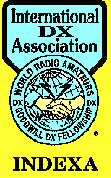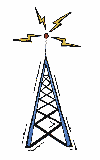|
This website can be viewed with:
To Website Map:
|
Your Connection to
the World!!!
Another website you should not miss is: W4RNL - Dr. L.B. Cebik's:
LB is a very interesting person to listen to. He missed his calling, as far as I'm concerned... he is a recently retired Professor of Psychology at the University of Tennessee (GO VOLS!!!) in Knoxville, Tenn. That's right, the same school my older son Rusty is attending (and is finally going to graduate from next year!!!) And about that calling: he knows more about antennas and antenna theory, than anybody I know-he would have contributed a lot to the science and the art of antenna engineering, had he chosen that field as his original course of study. A terrific lecturer, LB often delivers forums on antennas and related subjects at Hamfests all over the South. Go and see the website-it's truly worth the trip!!! He has a great discussion of the Extended Double Zepp Antenna at: EDZ
There is a terrific series of articles (60+ pages in pdf format, available from the ARRL website, by Walt Maxwell, entitled: Another Look At Reflections. It was published in QST between April 1973 and August 1976 (not continuously.) Just click on the title to hyperlink there. Thanks to Alan, KB7MBI for the tip that it was there!
I would like to recommend the program EZNEC by Roy Lewallen, W7EL. It is now out in a WINDOWS version, and is an extremely capable program for antenna modeling, or just looking at what an antenna should do. His website is: http://www.eznec.com or just click the button below
I finally 'bit the bullet' and bought Adobe's Acrobat so I could reproduce my Autosketch v7 drawings & schematics here on my website. It took a while to figure out how to get the drawings (they are "drawing.skf" files-which ONLY convert (normally) to Windows Meta File: "drawing.wmf" or Autocad: "drawing.dwg" or Autodesk Drawing Web Format: "drawing.dwf". The problem was that I'm running Windows 2000 Professional (e.g. WIN NT-5)... and from the starting instructions, etc. I thought I didn't have a Postscript driver installed. Searching around the Internet didn't help... and finally I decided to go to CONTROL PANEL > PRINTERS and try and find one on the original WIN 2000 Pro CD. It wasn't there BUT it WAS already installed as a Printer within the PRINTERS Folder. I made that 'PRINTER' the "default printer" and VOILA!!! When I then ran Autosketch v7, opened a drawing, and printed it, ultimately it was saved as the appropriate Acrobat: "drawing.pdf". Worked like a million $$$... and even worked when I sent it to myself as an attachment to an email. Now to put the antenna drawing, with a description, as a hyper-link (button/whatever.) The 1st antenna drawing shown here is not complete... I need to add a second page of DETAILS. I would appreciate it if anyone who got through all this rhetoric would let me know that the drawing turned out OK at their end. Thanks. Just click on the underlined title for the drawing.
This is a series of very interesting messages that evolved from a question on QRP-L (the email reflector). First, the question:
I saw this antenna in a publication somewhere several years ago, when UA1DZ passed away. The dimensions only. The drawing is mine. I haven't built one... but it's another one of those projects you'd really like to try, if only you could get the time. I am going to do a 2nd "details" page soon.
There is a lot of controversy surrounding the Double Bazooka. Probably its bandwidth claims have been exaggerated. I debated even listing it... but you know what? I used a 75M Double-Bazooka for years, with what I consider to be a great deal of success. I know at least one genuine expert who is certain that a shielded antenna at DC ground is not any quieter than your ordinary dipole. I'm reasonably convinced that there exists math that 'proves' this-based on the explanation I heard/read. However, my own experience with this antenna over a number of years strongly disagrees. Here's the story...
Several years ago, I ran an afternoon Army MARS SSB net just above 4 MHz at 4PM or 5PM local time here in Georgia. You know just how noisy 75M can be in the still-bright sun at that time of day: awful!!! I put that Double Bazooka up specifically looking for help with the summer noise levels. It was a max of maybe 30 ft in the center, down to about 6 ft on the ends. It was terrific. You could switch to the G5RV and back, and easily hear the serious difference. I found that I was often the only one who could copy some of the weaker (usually out of state) stations. I often copied LA, MS, AL, & SC check-ins-even in the summer. Occasionally, when the band was particularly bad, I was the only one able to consistently copy the entire net roster. Bottom line? I don't know why it was quieter, I just know it was. It seemed to get out just about as well. So, for local (<1000mi) QSOs, it sure was a winner for me. This design came to me from the late WA4EZN, Lucky.
P.S. I sure wish I could have compared it to a FW horizontal loop. I might even put up the pair, and see who wins!
These two antennas were designed-and patented (patent: US 6,452,553) by Chip Cohen, N1IR; and came to me through Cliff Donley, K8TND, who built them. The first: a "Serpiensky FRACTAL Bow-Tie" is for 2M and up. The second: a "GODSEYE 7-SQUARE FRACTAL" is for 450 kHz - 1 GHz. Cliff reports excellent results from both antennas. Both selections below yield the PDF Drawing. *** Coming Soon: A 20M or 30M Fractal Vertical ***
To continue browsing the website, please select from these categories: and from an Electronics perspective: |
![]() This website is
always
under construction...
This website is
always
under construction...
![]()



















